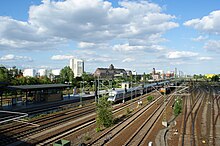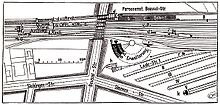Berlin Beusselstrasse train station
| Berlin Beusselstrasse | |
|---|---|
|
Beusselstraße S-Bahn station (left) with the neighboring long-distance railway line and freight station (right)
|
|
| Data | |
| Operating point type | Breakpoint |
| Platform tracks | 2 (S-Bahn) |
| abbreviation | BBEU |
| IBNR | 8089118 |
| Price range | 4th |
| opening |
May 1, 1894 December 19, 1999 |
| Conveyance | September 18, 1980 |
| Website URL |
bahnhof.de sbahn.berlin |
| location | |
| City / municipality | Berlin |
| Place / district | Moabit |
| country | Berlin |
| Country | Germany |
| Coordinates | 52 ° 32 '4 " N , 13 ° 19' 46" E |
| Railway lines | |
|
|
| Railway stations in Berlin | |
The Beusselstraße station is a S-Bahn station in the Berlin district of Moabit in the Mitte district . It is located at the Beusselbrücke, the overpass of Beusselstrasse over the Ringbahn .
history
Since the opening of the first section of the connecting line (later called "Ringbahn") on January 1, 1872, the Moabit station existed a little further east of today's station . This marked the beginning of the connecting line and is still the zero point of the route kilometers of the Berlin Ringbahn. Due to the growing demand for transport, the station was fundamentally rebuilt in the early 1890s. Passenger traffic and freight traffic were separated. On May 1, 1894, the new Beusselstraße stop at the Beusselbrücke went into operation for passenger traffic and on that day the Moabit station became a pure freight station.
The layout of the Beusselstrasse station could be described as a typical station of the Ringbahn. The station had a central platform and two exits. One was at the head of the platform at the Beussel Bridge, the other was in the middle and led away sideways. A single-row iron framework construction was used as the roof. The reception building in neo-Gothic style was on the bridge. In the first decades, trains with steam locomotives still ran there ; In the course of the “ Great Electrification ”, new railcars such as B. the type "Stadtbahn" ( ET 165 ) is used.
The plans drawn up by the National Socialists in the 1930s to transform Berlin into the world capital Germania envisaged extensive work on the northern ring line. All suburban traffic that was routed along this section on the outside should be routed uniformly to the inside. In addition, a so-called “long-distance S-Bahn” was planned between the newly planned north station (between the Westhafen and Wedding stations ) and the Siemensstadt-Fürstenbrunn station . At the Beusselstraße station, this should pass by the central platform of the S-Bahn. To the north of the suburban tracks, the freight station, which had also been moved, was to extend to supply the Berlin wholesale market at the Westhafen. The intervening Second World War prevented the implementation of these plans.
The Allied air raids , the reception building was World War II extensively damaged. It was only demolished in 1962 and then replaced by a low building as an entrance. The second entrance with the glazed pedestrian bridge known as the “greenhouse corridor” was then also removed.
In the 1970s, the station became the end point for trains coming from Spandau and Gartenfeld. The background to this was the closure of a platform at the Jungfernheide station to the west , so that the interrupting trains could no longer turn and thus had to continue to Beusselstrasse and return to the turning facility there.
On September 17, 1980, as a result of the Reichsbahn strike, all S-Bahn traffic in West Berlin was suspended . The systems were initially kept in their last condition until 1984, when the Berlin Passenger Association IGEB, also founded in 1980, moved into the reception building and set up a passenger center. Four years later, however, he had to leave the property because the Beussel Bridge was to be expanded and the building was in the way. In addition to this, a large part of the platform systems was also removed. In 1991 only fragments of the pillars and the station master's house remained.
In order to restart the northern ring line, it was initially considered to integrate the remaining supports into the new station. However, the decision was made to build a completely new one, as the new platform should also be moved under the Beussel Bridge in order to be able to create exits on both sides of the bridge. The festive reopening of the Jungfernheide - Beusselstraße - Westhafen section was on December 19, 1999 with the participation of the Governing Mayor Eberhard Diepgen .
At the S-Bahn platform, the train driver handles the train using the driver's cab monitor (ZAT-FM).
In the middle of the 2010s, a double-track sweeping system for intermittent trains is to be rebuilt east of the platform . A track change was installed west of the platform when it opened in 1999.
Freight station Berlin-Moabit

The Berlin-Moabit freight station is located south of the S-Bahn tracks between Beussel and Putlitz bridges . It extends to the east behind the Putlitz bridge. Its parking and loading siding extended to Siemensstrasse / Quitzowstrasse in the south and have now largely been dismantled.
During the National Socialist era , over 30,000 Jews were deported from the Moabit freight yard . Today a memorial on Putlitzbrücke , a memorial in Levetzowstraße and a memorial plaque on Quitzowstraße, where a memorial site is to be set up in the course of the redesign of the area, commemorate this.
Large parts of the freight yard were abandoned after 1990. In the southern area, commercial areas are being created, which u. a. to be used by a catering wholesaler. Erna-Samuel-Straße was built to develop the site, which at the same time relieves the southern residential areas of through traffic.
On September 24, 2012, the “Moabiter Stadtgarten”, consisting of a playground, sunbathing areas, an orchard and community gardens, was opened on a partial area of 15,000 m². The State of Berlin invested two million euros for this in the course of the “Urban Redevelopment West”. Parts of a goods shed that have been preserved have been integrated into the park and are to be reused.
The remaining tracks of the Moabit freight station are used today in particular to connect the West Harbor and the Moabit power station via a pull-out track at the former Hamburg-Lehrter freight station.
The building of the signal box Mwt with integrated water tower designed by Karl Cornelius and erected in 1892/1893 is now a listed building .
Connection
The S-Bahn station is served by the S41 and S42 ring lines and, on weekends, also by the S46 line. There are transfer options to the bus lines TXL, 106 and 123 of the BVG .
| line | course | Clock in the peak hours |
|---|---|---|
|
|
Gesundbrunnen - Schönhauser Allee - Prenzlauer Allee - Greifswalder Strasse - Landsberger Allee - Storkower Strasse - Frankfurter Allee - Ostkreuz - Treptower Park - Sonnenallee - Neukölln - Hermannstrasse - Tempelhof - Südkreuz - Schöneberg - Innsbrucker Platz - Bundesplatz - Heidelberger Platz - Hohenzollerndamm - Halensee - Westkreuz - Messe Nord / ICC - Westend - Jungfernheide - Beusselstraße - Westhafen - Wedding - Gesundbrunnen | 5 min |
|
|
Westend - Messe Nord / ICC - Westkreuz - Halensee - Hohenzollerndamm - Heidelberger Platz - Bundesplatz - Innsbrucker Platz - Schöneberg - Südkreuz - Tempelhof - Hermannstraße - Neukölln - Köllnische Heide - Baumschulenweg - Schöneweide - Schöneweide depot - Adlershof - Grünau - Eichwalde - Zeuthen - Wildau - Königs Wusterhausen | 20 min |
literature
- Berlin S-Bahn Museum (ed.): Endless route. The Berlin Ringbahn . Verlag GVE, Berlin 2002, ISBN 3-89218-074-1 .
- Alfred Gottwaldt: Moabit freight yard memorial. Hentrich & Hentrich, Berlin 2014, ISBN 978-3-95565-054-4 .
Web links
- Entry in the Berlin State Monument List with further information (Stellwerk Mwt)
- Beusselstraße station at stadtschnellbahn-berlin.de
Individual evidence
- ↑ Station price list 2020. In: Deutsche Bahn. Deutsche Bahn, January 1, 2020, accessed on July 10, 2020 .
- ↑ News in brief - S-Bahn . In: Berliner Verkehrsblätter . September 2014, p. 179 .
- ↑ Quitzowstrasse memorial plaque. sie-waren-nachbarn.de , accessed on February 22, 2013 .
- ↑ New memorial at Moabit freight station: Pines planted . At: berlin.de , April 20, 2017
- ↑ Levetzowstrasse memorial. Stiftung_Denkmal_für_die_ermordeten_Juden_Europas , accessed on June 18, 2020 .
- ↑ Land use plan - change. (PDF; 1.5 MB) Senate Department for Urban Development, accessed on February 22, 2013 .
- ↑ a b New garden at the freight yard. Der Tagesspiegel , May 4, 2011, accessed on February 22, 2013 .
- ↑ Long argument about a small park. Berliner Zeitung , September 25, 2012, accessed on February 22, 2013 .
- ↑ Implementation of an expression of interest procedure for the operation of buildings and public outdoor areas on parts of the premises of the Moabit freight yard. (PDF; 3.1 MB) Central District Office of Berlin, accessed on February 22, 2013 .




